- What is Dow Theory?
- History of Dow Theory
- The six tenets of Dow Theory a. History repeats itself b. The markets discount everything c. There are three types of market trends and four market phases d. Indices must confirm each other e. Volume must confirm the trend f. A trend is said to be continuous until a reversal is confirmed
What is Dow Theory?
The Dow Theory is a theory based on observations of Mr Charles Dow. These observations are known as tenets of the Dow Theory. Using this theory, you could easily understand what phase the market is in and make predictions about what is going to happen next.Recommended watch: Dow Theory in Hindi
History of Dow Theory
Mr Charles Dow introduced the Dow Theory to the world in 1896. He was the founder of Dow Jones & Company. He along with his friends Charles Bergstresse and Edward Jones co-founded the Wall Street Journal where he used to publish small portions of the Dow Theory. After creating the financial theory, he also created the first stock index, The Dow Jones Industrial Average which originally had only twelve companies in it. Today, it is the most-watched stock market index in the world which consists of the 30 largest, sector diversified and liquid companies listed in the U.S. After Mr Dow’s death, Mr William P. Hamilton compiled all the articles and refined the theory. He wrote a book - The Stock Market Barometer in 1922 in which he has explained the six tenets of the Dow Theory. Now, let’s move ahead and understand the six basic tenets of the Dow Theory.Six Tenets of Dow Theory
1. History repeats itself
This is one of the key assumptions of technical analysis. It believes that we humans behave in a similar way in different situations. So, when there is panic in the markets, investors tend to get fearful and sell their holdings. And when the market is constantly hitting new highs, investors tend to get greedy and buy more in anticipation of earning more profits. So, when investors are greedy, there will be more demand and less supply which pushes the stock prices up. On the other hand, when the investors are fearful, there will be more supply than demand which will push the stock prices down. This demand and supply of shares is the sole reason we see fluctuations in the market.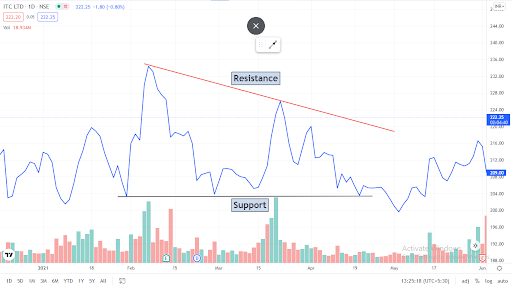 So, if we look at the chart above, whenever the share price is near to the support levels, it bounces back as the majority of investors believe that this is the right price to buy which causes high demand for shares and the stock price moves up.
On the other hand, when the share is near to the resistance level, the majority of investors believe that this is the right time to sell which causes the share price to fall.
So, if we look at the chart above, whenever the share price is near to the support levels, it bounces back as the majority of investors believe that this is the right price to buy which causes high demand for shares and the stock price moves up.
On the other hand, when the share is near to the resistance level, the majority of investors believe that this is the right time to sell which causes the share price to fall.
Recommended watch: What is support and resistance?
We see the formation of many such patterns in almost every chart and each pattern has a different interpretation. The Dow Theory states that such patterns have worked well in the past and they will continue to work well in the future as well.2. The markets discounts everything
This rule of Dow Theory states that the current market price of a share reflects everything that is happening in the economy. So, if there is a change in interest rates or an upcoming election or a company’s financial results, the share price will reflect all the information beforehand. For example, if the investors are expecting a good quarterly result of a company then, the markets will already factor this in the share price even before the announcement of the result. This way the share price factors in everything that’s going in and around the markets. Also, in case of a natural calamity or any sudden bad news, the markets will quickly factor the information into the share prices.3. There are three types of market trends and phases
Before we understand the three types of market trends, let’s quickly understand what is a trend. A trend is a direction in which the price of a share moves. There are three basic types of trends.- Uptrend
- Downtrend
- Sideways trend
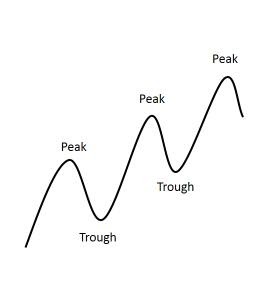 The above image is how a share price fluctuates. The upper end or the high of a trend is called the peak and the lower end is called the trough.
So, if a stock constantly keeps hitting higher peaks and higher troughs then it indicates that there is an uptrend. And if a stock hits lower peaks and lower troughs, it indicates a downtrend.
The third trend is the sideways trend. When a share trades at flat peaks and troughs, it is known as a sideways trend.
Now that we know what are the three types of trends. Let’s move ahead and understand the three components of a trend.
The above image is how a share price fluctuates. The upper end or the high of a trend is called the peak and the lower end is called the trough.
So, if a stock constantly keeps hitting higher peaks and higher troughs then it indicates that there is an uptrend. And if a stock hits lower peaks and lower troughs, it indicates a downtrend.
The third trend is the sideways trend. When a share trades at flat peaks and troughs, it is known as a sideways trend.
Now that we know what are the three types of trends. Let’s move ahead and understand the three components of a trend.
- Primary trend
- Secondary trend
- Minor trend
- The primary trend represents the tide.
- The secondary trend represents the waves hitting the seashore.
- The minor trend behaves like ripples which are formed when you throw a pebble into still water.
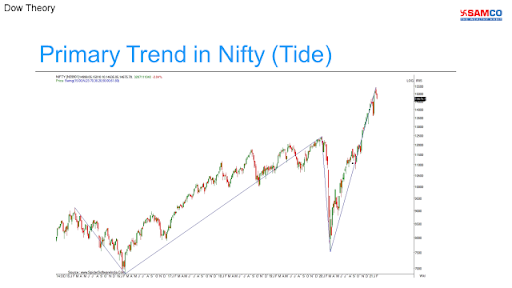 Here is an example of a primary trend. This is a weekly chart of Nifty 50 since 2015. As you can see, during the time frame of 2015-2016, the markets were in a bearish trend. Later in February 2016, we saw a reversal and the markets have been in a bullish phase for almost four years until we saw the Covid-19 market crash.
Now, let’s look at an example of the secondary trend. In the same chart above we have highlighted the secondary trend using a different time frame.
Here is an example of a primary trend. This is a weekly chart of Nifty 50 since 2015. As you can see, during the time frame of 2015-2016, the markets were in a bearish trend. Later in February 2016, we saw a reversal and the markets have been in a bullish phase for almost four years until we saw the Covid-19 market crash.
Now, let’s look at an example of the secondary trend. In the same chart above we have highlighted the secondary trend using a different time frame.
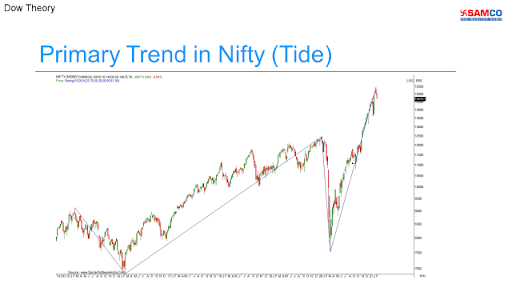 So as you can see, there are constant fluctuations in the chart above. The reversals and corrections are seen every few weeks or months. This is an example of a secondary trend. It lasts for a shorter term than the primary trend.
So as you can see, there are constant fluctuations in the chart above. The reversals and corrections are seen every few weeks or months. This is an example of a secondary trend. It lasts for a shorter term than the primary trend.
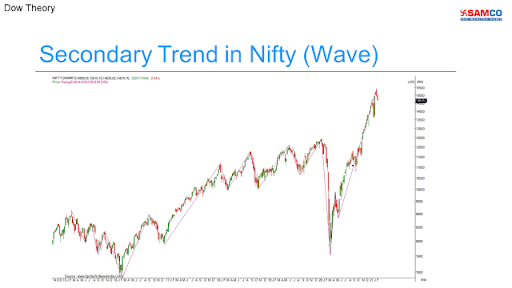 Lastly, let’s look at an example of a minor trend. In the chart, we have plotted data after January 2020. As you can see, the trend changes quickly and it sustains for a very short term.
Lastly, let’s look at an example of a minor trend. In the chart, we have plotted data after January 2020. As you can see, the trend changes quickly and it sustains for a very short term.
Watch the video to learn more about the three trends of the markets.
Now that we know the three trends of the market, let’s move ahead and understand the four phases of the market. The Four Market Phases Just as nature, the markets are cyclical too. The stock market cycle has four different phases.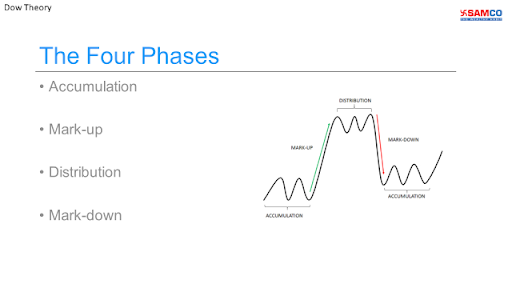
- Accumulation phase
- Mark-up phase
- Distribution phase
- Mark down phase
Learn how to use the four phases of the market and make profitable trades.
4. Indices must confirm with each other
The Dow Theory states that indices confirm each other. But what does that mean? Let’s say today morning you saw that CNX Nifty has opened in green. Does this mean that the markets are in an upward trend? No, this is not how we evaluate a trend. According to the Dow Theory, trends cannot be confirmed by only one index. We would say that the markets are in a bullish phase only when all the indices such as Nifty 50 index, Nifty mid cap index, Nifty small cap index, Bank Nifty move in the same direction. Take a look at the chart below. We have plotted the performance of Bank Nifty and Nifty 50. If you carefully see both the benchmark indices confirm each other while forming highs and lows.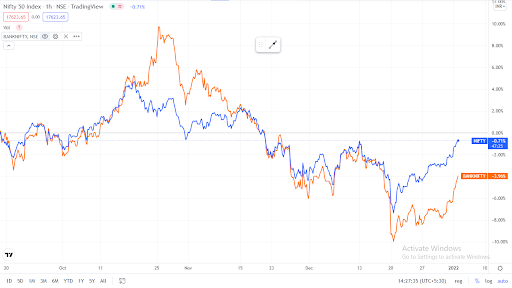
5. Volume must confirm the trend
Mr. Dow states that volume is a secondary indicator. According to his theory, volume and trend must justify each other. When a stock is in an uptrend, the volume must increase with rising prices. When the stock is moving in a sideways direction, the volume must reduce. And when the stock prices are falling, the volume must increase again. In short, a strong market trend should correspond with a high trading volume. If the stock is in an uptrend but isn’t recording high trading volume, then it is a weak uptrend. Let’s take an example.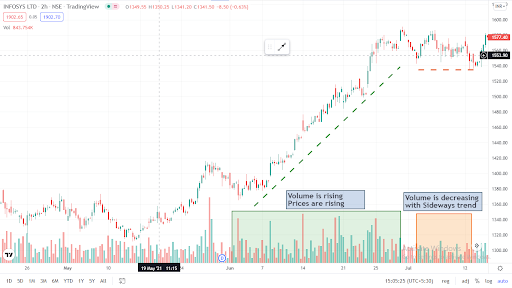
Chart of Infosys Ltd.
The bars below the chart refer to the volume recorded on a particular trading day. If you carefully see the highlighted section in green, there is a rise in volume as the share price is increasing. This shows that traders are willing to buy the share in anticipation of an upward momentum. Whereas, when the share starts trading sideways (section highlighted in red), the volume has drastically reduced.


 Easy & quick
Easy & quick
Leave A Comment?